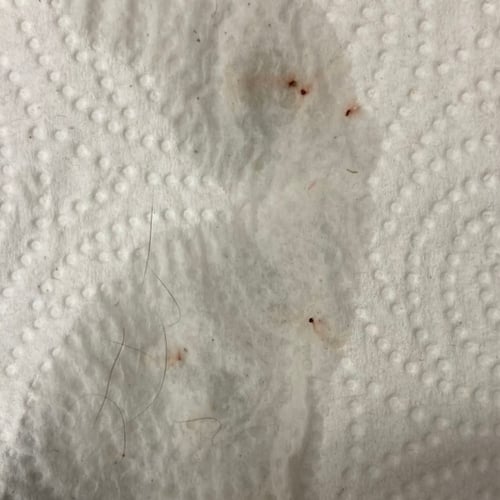
First, your cat or dog starts to itch, lick themselves more often (also called overgrooming), or bite their butt and legs.
Then you look further and you notice small black bits of dirt or maybe see a live flea on your pet.
Don’t panic!
Flea infestations are a big nuisance and are generally preventable, but if your pet is suffering from flea bites, then read on for some guidance on what to do.
Skip to section:
What Does a Flea Infestation Look Like in Dogs and Cats?
Flea infestations in dogs and cats can look a bit different. Dogs are often affected in their “pants area,” meaning their rump, the base of their tail, and their back legs. This can sometimes also spread to their inner thighs and belly.
Dogs will chew, bite, lick, or scratch at these spots, leading to skin redness, hot spots (moist areas of more severe inflammation and infection), and hair loss.
Cats often show overgrooming with hair loss over their backs, shoulders, and the backs of their necks. They can sometimes develop small, crusted bumps in these areas, also known as miliary dermatitis.
Dogs and cats will both often show “flea dirt” in their affected areas. This “dirt” is actually small grains of flea feces and appears like grainy, black debris on the skin or in the hairs where your pet is bothering themselves.
You can tell this is “flea dirt” and not regular dirt by wiping some of the debris onto a moist paper towel (see photo example below). You can use a flea comb if you have one, to pull the fleas or dirt from your pet's fur. If the grains start to melt into red or rust-colored smears, that suggests this is flea dirt.

If you find fleas, then they'll likely be moving. Fleas are tiny, narrow, dark-brown creatures and they often jump away very fast. If you pull a flea off your pet, you can quickly kill it by pouring rubbing alcohol on it.
If you see one flea, there are likely more fleas, either on your pet or in your environment.

Are Fleas Contagious?
Unfortunately, fleas are very contagious. Fleas on one pet in your home will quickly spread to other dogs and cats in your household. They can also spread to other pets that regularly come in contact with your pets, so please keep your pets separate from other animals outside the household until their infestation is treated.
Fleas can also jump on and bite humans, but they usually don’t live on you. If you see small red, itchy bites on your arms and legs or in other areas in frequent contact with your pet, it is a good idea to talk to your doctor and have your pet checked by a veterinarian!
Zoonotic Diseases
When any infection or disease is naturally transmitted from an animal to a human, it is referred to as a zoonosis. The infectious agent can be a bacteria, virus, fungus, or parasite.
Fleas can carry several diseases that can affect your dog AND your family. For humans, while rare, a flea bite can transmit cat scratch fever, typhus, and even the bubonic plague in some parts of the U.S. Pets and children that live in homes with fleas can accidentally ingest them, resulting in tapeworms as well.
Your pet can become infected with tapeworms while grooming themselves.
Tapeworms are intestinal parasites and can look like small, moving grains of rice in your pet’s poop. They are officially diagnosed by your veterinarian through fecal evaluation and require a prescription dewormer to treat (it’s a good idea to bring a poop sample with you to your appointment!).
How Do You Diagnose a Flea Infestation?
Flea infestations are primarily diagnosed based on appearance. If your dog or cat is itching severely in a particular area on their body where fleas like to live, that strongly suggests this diagnosis, even if you don’t see a flea or flea dirt.
Most of the time, your veterinarian will suggest providing treatment to rule out a flea infestation if your pet looks like they could have fleas and they’re not already taking a preventive medication.
Seeing a live flea and flea dirt on your pet confirms this diagnosis, at which point a flea preventive treatment would be needed to clear up the problem.

How Do You Treat a Flea Infestation?
There are many flea-preventive medications in many forms, including oral chews, topical spot-ons, and collars.
List of flea preventatives for dogs
List of flea preventatives for cats
There are also several generic versions of some older topical (spot-on) products that can be found at different stores. If you do buy an over-the-counter product, make sure to check carefully to make sure it is safe for your pet’s species, age, and the correct dose for your pet’s weight.
Warning for cats: Cats can often have dangerous reactions to many ingredients in dog flea preventives, so it’s important to make sure that you are NOT applying a dog product to your cat.
Dog products that are especially toxic to cats include pyrethrin or permethrin – these should not be used on cats or even on dogs that spend a lot of time in physical contact with your cat (snuggling, sleeping together, etc.).
Additionally, flea baths are NEVER a good idea for cats – they are often very toxic and can cause seizures or even death.
We do not recommend that you use flea baths (never for cats) or shampoos on your pet because there are much better, stronger, safer treatments available.
It is always better to bring your pet to your veterinarian to be checked out if you suspect fleas because prescription flea products are usually more effective than the ones you can buy in stores over the counter.
Also, your pet could have additional issues due to their flea infestation, such as a skin infection or an intestinal parasite, that your vet would be best able to treat.
Additionally, flea infestations are very itchy, and your vet can prescribe several treatment options to make your pet more comfortable.
Serious Safety Note Regarding Certain Preventatives: Some dogs and cats may carry a genetic mutation (MDR1) that makes them sensitive to common medications including some preventatives. If your pet has this mutation, standard doses (or any use) could cause severe adverse reactions.
An MDR1 test can help your veterinarian tailor safe and effective treatments. Click here for a full list of medications for cats to be cautious about, a full list of medications for dogs to be cautious about, and to order tests.
How Long Will You Have to Treat for Fleas?
Most flea preventives will start to kill fleas within 24 hours, often much sooner, and will kill off all the fleas on your pet within a few days. However, fleas also like to live and lay eggs in the shady, darker areas of your home and yard, so full flea treatment can often take several months to complete.
A flea life cycle from egg hatching to adult flea takes 3–4 weeks, and not all flea life stages can be killed by your pet’s parasite preventives. Some preventatives only affect adult fleas or juvenile fleas, and none of them will kill flea eggs once they're laid.
Therefore, you need to wait for fleas to hatch and reach the life cycles that can be killed multiple times in order for all the fleas in your environment to die.
This whole process of killing multiple life cycles usually takes 3–4 months, so it’s a good idea to keep your pet on a flea preventive during that time.
If you have a very large flea infestation, it would also be a good idea to speak to an exterminator about pet-safe options for treating your home and yard for fleas.
Read our tips and solutions for getting rid of fleas in your home.

Flea Dermatitis: When Your Pet Is Allergic to Fleas
Your pet can have a flea allergy in addition to just a flea infestation. Flea allergies are allergic reactions to flea saliva, which pets are exposed to when a flea bites them.
If your pet has a flea allergy, they can become extremely itchy even after one flea bite, so you won’t see a large amount of flea dirt or live fleas on them. If your flea-allergic pet does have a lot of fleas on them, they will probably be even itchier and redder than a non-allergic pet with the same problem.
Flea allergies are usually diagnosed by discussing your pet’s history with your veterinarian, though you can test for flea allergies through an allergy test.
Most of the time, if your pet has a history of becoming extremely itchy after a mild flea exposure, your doctor will say that your pet is flea allergic.
Testing for flea allergies alone is not necessary, though if your pet has an allergy test for other environmental allergies, a test for flea allergies is usually included.
Flea allergies are treated by keeping all the eligible pets in your household on consistent flea prevention to reduce the risk of flea bites and infestations in the future.
What Else Could Be Causing Your Pet to Itch?
Other possible causes of itching could include other parasites, such as scabies mites or Demodex mites, food or environmental allergies (pollen, dust mites, etc.), skin infections, or contact allergies.
If your pet is treated for fleas and is still itchy, it is a good idea to talk to your primary veterinarian about other reasons for this continued itching and what next steps they recommend to find the cause. They may recommend allergy testing and/or refer your pet to a veterinary dermatology specialist.
How Do You Prevent Flea Infestations in the Future?
The best way to prevent flea infestations is to make sure all the pets in your home are on flea preventatives regularly. Fleas can be a problem year-round in most environments, even in suburban areas or cities. Therefore, keeping your pet on a year-round flea preventative will keep them as safe as possible from fleas.
Read more on flea prevention.



